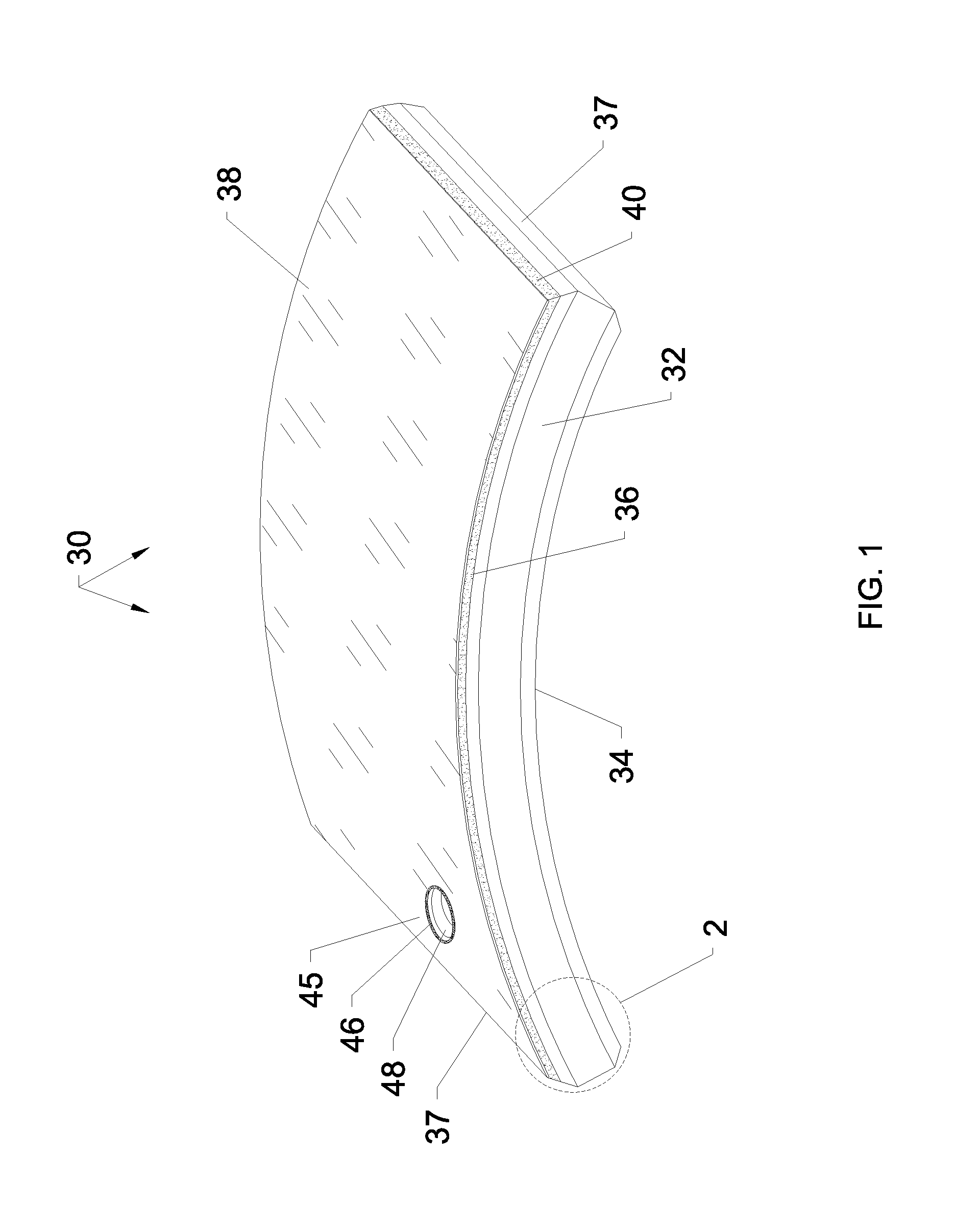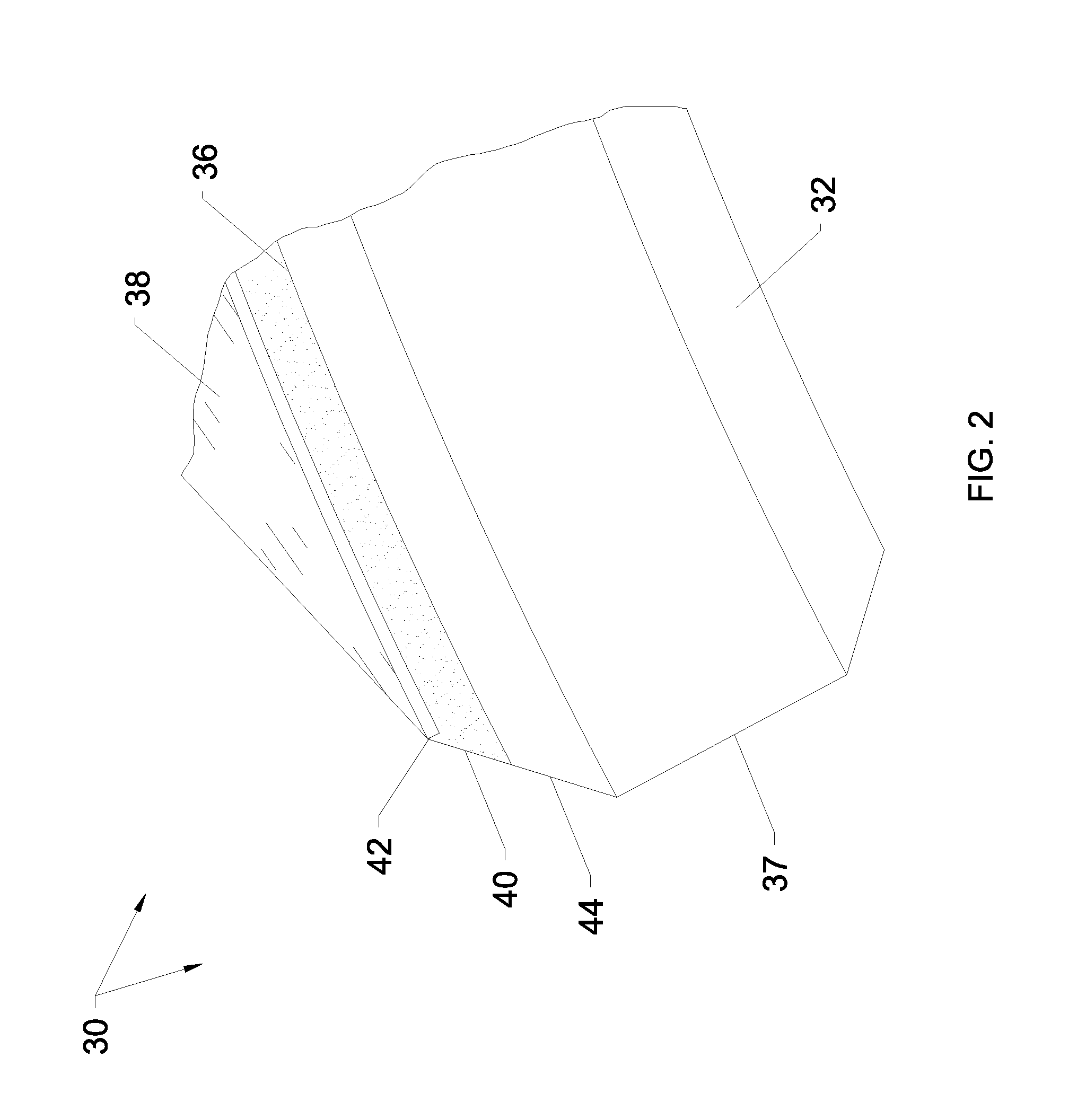Heat-strengthened glass has deep residual stresses that, if released, also cause a self-propagating fracture pattern but into larger pieces.
Heat-treated bent glass has relatively fast rates of production, owing to the quick cycle of heating, bending, and rapid cooling.
The corresponding tension stress, the same forces which cause fully-tempered glass to disintegrate into small particles, are distributed across the remaining thickness at a lower level insufficient to result in a granular fracture pattern except on very thin sheets.
Chemically-strengthened glass without secondary lamination is not classified as a safety glass because of this typically larger fracture pattern.
Non-heat-treated, bent glass has slow rates of production with long cycles of heating, bending, and cooling, plus multiple secondary hours in a salt tank, if chemically-strengthened properties are required.
However, the shape conformance is less accurate than non-heat-treated bent glass, because the deep residual stresses always slightly alter the shape with some level of unpredictability.
Once the glass is heat-treated, excessive thermal or mechanical loads including by impact may result in breakage with the release of internal residual stress and subsequent disintegration, explosively in the case of fully-tempered glass.
However there always remains a risk of such failure occurring spontaneously even years after production due to imperfections in the glass.
For example, the presence of microscopic inclusions of nickel-sulfide contaminant in raw flat glass sheets which increase in size over time is a well documented cause of spontaneous breakage.
Additionally, damage or dimensional changes to the glass edges or surfaces after heat-treating instead of causing immediate breakage may result in instability causing spontaneous breakage at a later time.
Spontaneous breakage, though a rare occurrence, is a more pronounced risk with the higher residual stresses of fully-tempered glass than the lesser residual stresses of heat-strengthened glass.
Recently, there have been numerous reports of incidents of spontaneous breakage occurring in single fully-tempered glass pieces installed overhead in vehicle sunroofs which have highlighted the potential risk of the phenomenon in all heat-treated glass applications.
Regardless of the cause of breakage, the resulting release of internal residual stress causes fracturing of the heat-treated glass sheet into unbound glass particles.
However, a sprayed polymer with pristine optical clarity for a vision application, hardiness for open exposure to the environment, as well as repellent of soiling has proved elusive.
However applied films are vulnerable to degradation from the environment, including yellowing, scratching, peeling, or abrasions and add expense not just for initial installation but also field maintenance.
However the exposed face of the polymer sheet is also vulnerable to environmental damage and even tiny specks of dust adjoining the sacrificial layer during processing produce blisters in the polymer surface and poor optical quality.
There is an ongoing industry effort to transition away from the installation of single sheets of fully-tempered safety glass in locations directly overhead, where the unsecured release of energy within the glass may result in disintegration and the release of falling glass particles, presenting a safety hazard.
In the latter building code, traditional single pieces of fully-tempered safety glass are limited to applications “where there is no walking surface beneath them or the walking surface is permanently protected from the risk of falling glass”.
However, this approach, which typically characterizes flat, laminated glass production where bullet resistance or blast resistance is not required, has distinct drawbacks in the production of bent laminated glass products, and their resulting characteristics.
However, laminated, non-heat-treated, annealed bent glass lacks enhanced strength and, as a result, is vulnerable to cracking from both thermal stresses and mechanical weakness.
Additionally, there may be slight misalignment in the edges of component annealed glass layers after lamination, which may require repolishing if installed with an exposed edge condition.
Repolishing already curved glass is a laborious process and in combination with the dull interlayer in the center of the thickness, bent laminated annealed glass panels never attain the high level of monolithic gloss finish possible with machine polished, single heat-treated pieces.
Most importantly however bent, laminated, annealed glass is without strength enhancement in the glass layers and is at increased risk for cracking under thermal or mechanical loading.
Cracking may result from mechanical loads if, for example, the glass panel is subject to high winds, accidentally “knocked” on exposed perimeter edges, or especially if subject to the high localized forces of mounting hardware attached through perforations in the glass.
Additionally, cracking may result from thermal loads if for example an exterior glass panel is subject to high levels of solar energy absorption as occur with darkly tinted, spandrel, and low-emissivity coated glass, especially with simultaneous conditions of partial shading across the panel.
Furthermore, glass with ceramic-frit paint fired into the surface during bending not only blocks the strengthening in painted areas but may introduce salt bath contaminants.
Finally, laminated, chemically-strengthened glass is relatively more expensive due to its slow rate of production.
However, all bent laminated glass panels assembled from layers of chemically-strengthen
 Login to View More
Login to View More 


